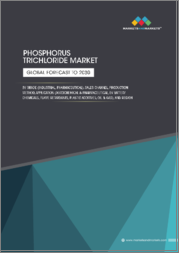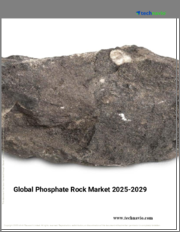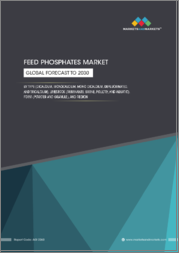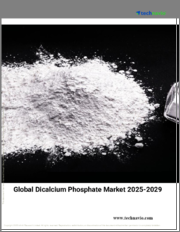
|
시장보고서
상품코드
1620667
세계의 인산염 시장 : 유도체 유형별, 용도별 - 예측(2025-2030년)Phosphates Market by Derivative Type (Ammonium Phosphate, Calcium Phosphate, Phosphoric Acid), Application (Feed Additives, Fertilizers & Pesticide, Food & Beverage) - Global Forecast 2025-2030 |
||||||
인산염 시장은 2023년에 797억 5,000만 달러로 평가되었습니다. 2024년에는 833억 7,000만 달러에 이를 것으로 예측되며 CAGR 4.62%로 성장해 2030년에는 1,094억 3,000만 달러에 이를 것으로 예측됩니다.
인산염은 주로 화학적 특성으로 인해 다양한 산업에서 중요한 역할을 하며 다양한 용도를 가능하게 합니다. 비료, 세제, 식품 첨가물, 산업용 등 다양한 형태로 존재합니다. 인산염의 필요성은 주로 식물 성장에 필수적인 영양가 때문이며, 작물 수확량을 향상시키는 농업에서 인산염은 필수 불가결한 요소입니다. 또한 인산염의 완충 능력과 다른 화합물과의 호환성은 식품 보존 및 강화, 수처리 공정, 심지어 의약품 제조를 위한 제약 산업에서 인산염을 필수 불가결한 요소로 만듭니다. 인산염의 최종 용도는 농업, 식음료, 산업용 세정 및 개인 위생에 이르기까지 다양합니다. 인산염 시장에 영향을 미치는 주요 성장 요인으로는 세계 인구 증가에 따른 식량 생산 수요 증가로 인해 인산염 비료의 사용률이 증가하고 있습니다. 또한, 기술 발전으로 채굴 및 가공 능력이 강화되면서 인산염의 가용성이 향상되고 있습니다. 환경 친화적인 대체품이나 폐수 처리 시설과 같은 폐기물 흐름에서 지속 가능한 인산염 회수 공정을 개발하면 비즈니스 기회가 창출될 수 있습니다. 과제로는 원료 가격 변동, 인광석 채굴 및 사용에 대한 엄격한 환경 규제, 시장 성장을 저해할 수 있는 대체품의 가용성 등을 들 수 있습니다. 연구개발과 혁신의 기회는 효율적인 인산염 재활용 방법의 개발과 환경에 미치는 영향을 최소화하는 지속 가능한 추출 공정의 개발에서 찾을 수 있습니다. 시장은 경쟁이 치열하며, 유기농업의 발전은 천연 인광석 공급원에 대한 미래 수요를 견인할 수 있는 잠재력을 가지고 있습니다. 생산과 무역에 영향을 미치는 지정학적 상황의 영향을 받는 인광석 시장의 순환적 특성을 고려할 때, 기업은 경쟁력을 유지하기 위해 지속 가능한 관행과 기술 혁신에 전략적으로 투자해야 합니다. 지속 가능한 개발과 자원 효율성 향상에 집중함으로써 기업은 유기농 식품 및 친환경 산업 응용 분야와 같은 신흥 시장 확대를 활용하여 장기적인 성장과 회복력을 확보 할 수 있습니다.
| 주요 시장 통계 | |
|---|---|
| 기준 연도(2023년) | 797억 5,000만 달러 |
| 추정 연도(2024년) | 833억 7,000만 달러 |
| 예측 연도(2030년) | 1,094억 3,000만 달러 |
| CAGR(%) | 4.62% |
시장 역학: 빠르게 진화하는 인산염 시장의 주요 시장 인사이트 공개
인산염 시장은 수요 및 공급의 역동적인 상호작용을 통해 변화하고 있습니다. 이러한 시장 역학의 변화를 이해함으로써 기업은 정보에 입각한 투자 결정을 내리고, 전략적 의사결정을 정교화하며, 새로운 비즈니스 기회를 포착할 수 있습니다. 이러한 트렌드를 종합적으로 파악함으로써 기업은 정치적, 지리적, 기술적, 사회적, 경제적 영역 전반에 걸친 다양한 리스크를 줄일 수 있으며, 소비자 행동과 그것이 제조 비용 및 구매 동향에 미치는 영향을 보다 명확하게 이해할 수 있습니다.
- 시장 성장 촉진요인
- 농업 생산성 향상을 위한 효율적인 비료에 대한 수요 증가
- 식품 가공 산업에서 식품 첨가물로 사용
- 수처리 응용 분야에 광범위하게 사용
- 시장 성장 억제요인
- 인광석 매장량 한계로 인한 우려
- 시장 기회
- 차세대 사료용 인산염의 등장
- 제약 부문에서 인산염 응용 분야 증가
- 시장 과제
- 과잉 사용에 따른 환경 문제
Porter's Five Forces: 인산염 시장 탐색을 위한 전략 도구
Porter's Five Forces 프레임워크는 인산염 시장 경쟁 구도를 이해하는 데 중요한 도구입니다. Porter의 Five Forces 프레임워크는 기업의 경쟁을 평가하고 전략적 기회를 모색하기 위한 명확한 방법을 설명합니다. 이 프레임워크는 기업이 시장 내 세력도를 평가하고 신규 사업의 수익성을 판단하는 데 도움이 됩니다. 이러한 통찰력을 통해 기업은 강점을 활용하고, 약점을 보완하고, 잠재적 도전을 피하고, 보다 강력한 시장 포지셔닝을 확보할 수 있습니다.
PESTLE 분석 : 인산염 시장에서의 외부 영향 파악
외부 거시 환경 요인은 인산염 시장의 성과 역학을 형성하는 데 매우 중요한 역할을 합니다. 정치적, 경제적, 사회적, 기술적, 법적, 환경적 요인에 대한 분석은 이러한 영향을 탐색하는 데 필요한 정보를 담고 있으며, PESTLE 요인을 조사함으로써 기업은 잠재적 위험과 기회를 더 잘 이해할 수 있습니다. 이러한 분석을 통해 기업은 규제, 소비자 선호도, 경제 동향의 변화를 예측하고 선제적이고 적극적인 의사결정을 내릴 준비를 할 수 있습니다.
시장 점유율 분석 : 인산염 시장에서경쟁 구도 파악
인산염 시장의 상세한 시장 점유율 분석을 통해 공급업체의 성과를 종합적으로 평가할 수 있습니다. 기업은 수익, 고객 기반, 성장률과 같은 주요 지표를 비교하여 경쟁적 위치를 파악할 수 있습니다. 이 분석은 시장의 집중화, 세분화 및 통합 추세를 파악할 수 있으며, 공급업체는 치열한 경쟁 속에서 자신의 입지를 강화할 수 있는 전략적 의사결정을 내리는 데 필요한 통찰력을 얻을 수 있습니다.
FPNV 포지셔닝 매트릭스: 인산염 시장에서공급업체 성과 평가
FPNV 포지셔닝 매트릭스는 인산염 시장에서 공급업체를 평가할 수 있는 중요한 도구입니다. 이 매트릭스를 통해 비즈니스 조직은 벤더의 비즈니스 전략과 제품 만족도를 기반으로 벤더를 평가하여 목표에 부합하는 정보에 입각한 의사결정을 내릴 수 있으며, 4개의 사분면으로 벤더를 명확하고 정확하게 세분화하여 전략 목표에 가장 적합한 파트너와 솔루션을 식별할 수 있습니다. 전략 목표에 가장 적합한 파트너와 솔루션을 식별할 수 있습니다.
전략 분석 및 추천: 인산염 시장에서 성공의 길을 그립니다.
인산염 시장 전략 분석은 세계 시장에서 입지를 강화하고자 하는 기업에게 필수적입니다. 주요 자원, 역량 및 성과 지표를 검토함으로써 기업은 성장 기회를 식별하고 개선할 수 있습니다. 이러한 접근 방식은 경쟁 환경의 도전을 극복하고 새로운 비즈니스 기회를 활용하여 장기적인 성공을 거둘 수 있는 체계를 구축할 수 있도록 도와줍니다.
이 보고서는 주요 관심 부문에 대한 종합적인 시장 분석을 제공합니다.
1. 시장 침투도 : 현재 시장 환경의 상세한 검토, 주요 기업의 광범위한 데이터, 시장 도달 범위 및 전반적인 영향력을 평가합니다.
2. 시장 개척도: 신흥 시장에서의 성장 기회를 파악하고, 기존 부문의 확장 가능성을 평가하며, 미래 성장을 위한 전략적 로드맵을 기술하고 있습니다.
3. 시장 다각화 : 최근 제품 출시, 미개척 지역, 산업의 주요 발전, 시장을 형성하는 전략적 투자를 분석합니다.
4. 경쟁 평가 및 정보 : 경쟁 구도를 철저히 분석하여 시장 점유율, 사업 전략, 제품 포트폴리오, 인증, 규제 당국의 승인, 특허 동향, 주요 기업의 기술 발전 등을 검토합니다.
5. 제품 개발 및 혁신 : 미래 시장 성장을 가속할 것으로 예상되는 첨단 기술, 연구 개발 활동 및 제품 혁신을 강조합니다.
또한, 이해관계자들이 충분한 정보를 바탕으로 의사결정을 내릴 수 있도록 중요한 질문에 대한 답변도 제공합니다.
1. 현재 시장 규모와 향후 성장 전망은?
2. 최고의 투자 기회를 제공하는 제품, 지역은?
3. 시장을 형성하는 주요 기술 동향과 규제의 영향은?
4. 주요 벤더의 시장 점유율과 경쟁 포지션은?
5.벤더 시장 진입 및 철수 전략의 원동력이 되는 수익원과 전략적 기회는 무엇인가?
목차
제1장 서문
제2장 조사 방법
제3장 주요 요약
제4장 시장 개요
제5장 시장 인사이트
- 시장 역학
- 성장 촉진요인
- 성장 억제요인
- 기회
- 과제
- 시장 세분화 분석
- Porter's Five Forces 분석
- PESTEL 분석
- 정치
- 경제
- 사회
- 기술
- 법률
- 환경
제6장 인산염 시장 : 유도체 유형별
- 서론
- 인산암모늄
- 인산칼슘
- 인산
- 인산칼륨
- 삼인산나트륨
제7장 인산염 시장 : 용도별
- 서론
- 사료첨가물
- 비료 및 농약
- 식품 및 음료
- 수처리
제8장 아메리카의 인산염 시장
- 서론
- 아르헨티나
- 브라질
- 캐나다
- 멕시코
- 미국
제9장 아시아태평양의 인산염 시장
- 서론
- 호주
- 중국
- 인도
- 인도네시아
- 일본
- 말레이시아
- 필리핀
- 싱가포르
- 한국
- 대만
- 태국
- 베트남
제10장 유럽, 중동 및 아프리카의 인산염 시장
- 서론
- 덴마크
- 이집트
- 핀란드
- 프랑스
- 독일
- 이스라엘
- 이탈리아
- 네덜란드
- 나이지리아
- 노르웨이
- 폴란드
- 카타르
- 러시아
- 사우디아라비아
- 남아프리카공화국
- 스페인
- 스웨덴
- 스위스
- 터키
- 아랍에미리트(UAE)
- 영국
제11장 경쟁 구도
- 시장 점유율 분석, 2023년
- FPNV 포지셔닝 매트릭스, 2023년
- 경쟁 시나리오 분석
- 전략 분석과 제안
기업 리스트
- Arkema S.A.
- BASF SE
- Chevron Phillips Chemical Company LLC.
- Clariant AG
- Covestro AG
- DuPont de Nemours, Inc.
- Eastman Chemical Company
- EuroChem Group
- Evonik Industries AG
- Exxon Mobil Corporation
- INEOS AG
- Innophos Holdings, Inc.
- Lanxess AG
- Merck KGaA
- MITSUI CHEMICALS, INC.
- Nutrien Ltd.
- Prayon SA
- SABIC
- Sumitomo Chemical Co., Ltd.
- Tata Chemicals Ltd.
- The Dow Chemical Company
- The Mosaic Company
- Tokyo Chemical Industry Co., Ltd.
- Yara International ASA
- Yuntianhua Group Co., Ltd.
The Phosphates Market was valued at USD 79.75 billion in 2023, expected to reach USD 83.37 billion in 2024, and is projected to grow at a CAGR of 4.62%, to USD 109.43 billion by 2030.
Phosphates play a crucial role in various industries due primarily to their chemical properties, enabling diverse applications. They exist in different forms such as fertilizers, detergents, food additives, and in industrial applications. The necessity of phosphates primarily stems from their nutrient value critical for plant growth, which makes them indispensable in agriculture to improve crop yields. Furthermore, phosphates' buffering capacity and compatibility with other compounds make them vital in food preservation and enhancement, water treatment processes, and even in the pharmaceutical industry for drug manufacturing. The end-use scope of phosphates spans agriculture, food and beverages, industrial cleaning, and personal care. Key growth factors influencing the phosphate market include the rising demand for food production to support an increasing global population, leading to higher utilization of phosphate fertilizers. Additionally, advancements in technology have spurred enhanced mining and processing capabilities, thus improving phosphate availability. Opportunities emerge from eco-friendly alternatives and the development of sustainable phosphate recovery processes from waste streams like wastewater treatment plants. Challenges include fluctuating raw material prices, stringent environmental regulations concerning phosphate mining and usage, and the availability of substitutes which may hinder market growth. Research and innovation opportunities lie in the development of efficient phosphate recycling methods and the creation of sustainable extraction processes that minimize environmental impact. The market exhibits a competitive landscape with significant developments in organic agriculture, potentially driving future demand for natural phosphate sources. Given the cyclical nature of the phosphate market influenced by geopolitical situations affecting production and trade, companies must strategically invest in sustainable practices and innovation to remain competitive. By focusing on sustainable development and enhancing resource efficiency, businesses can capitalize on expanding markets such as organic foods and environmentally friendly industrial applications, thus ensuring long-term growth and resilience.
| KEY MARKET STATISTICS | |
|---|---|
| Base Year [2023] | USD 79.75 billion |
| Estimated Year [2024] | USD 83.37 billion |
| Forecast Year [2030] | USD 109.43 billion |
| CAGR (%) | 4.62% |
Market Dynamics: Unveiling Key Market Insights in the Rapidly Evolving Phosphates Market
The Phosphates Market is undergoing transformative changes driven by a dynamic interplay of supply and demand factors. Understanding these evolving market dynamics prepares business organizations to make informed investment decisions, refine strategic decisions, and seize new opportunities. By gaining a comprehensive view of these trends, business organizations can mitigate various risks across political, geographic, technical, social, and economic domains while also gaining a clearer understanding of consumer behavior and its impact on manufacturing costs and purchasing trends.
- Market Drivers
- Growing need for efficient fertilizers to enhance agricultural productivity
- Utilization as food additive in food processing industries
- Extensive use for water treatment applications
- Market Restraints
- Concerns associated with limited phosphate reserves
- Market Opportunities
- Emergence of the next-generation feed-grade phosphate
- Increasing application of phosphates in pharmaceutical sector
- Market Challenges
- Environmental concerns associated with excessive use
Porter's Five Forces: A Strategic Tool for Navigating the Phosphates Market
Porter's five forces framework is a critical tool for understanding the competitive landscape of the Phosphates Market. It offers business organizations with a clear methodology for evaluating their competitive positioning and exploring strategic opportunities. This framework helps businesses assess the power dynamics within the market and determine the profitability of new ventures. With these insights, business organizations can leverage their strengths, address weaknesses, and avoid potential challenges, ensuring a more resilient market positioning.
PESTLE Analysis: Navigating External Influences in the Phosphates Market
External macro-environmental factors play a pivotal role in shaping the performance dynamics of the Phosphates Market. Political, Economic, Social, Technological, Legal, and Environmental factors analysis provides the necessary information to navigate these influences. By examining PESTLE factors, businesses can better understand potential risks and opportunities. This analysis enables business organizations to anticipate changes in regulations, consumer preferences, and economic trends, ensuring they are prepared to make proactive, forward-thinking decisions.
Market Share Analysis: Understanding the Competitive Landscape in the Phosphates Market
A detailed market share analysis in the Phosphates Market provides a comprehensive assessment of vendors' performance. Companies can identify their competitive positioning by comparing key metrics, including revenue, customer base, and growth rates. This analysis highlights market concentration, fragmentation, and trends in consolidation, offering vendors the insights required to make strategic decisions that enhance their position in an increasingly competitive landscape.
FPNV Positioning Matrix: Evaluating Vendors' Performance in the Phosphates Market
The Forefront, Pathfinder, Niche, Vital (FPNV) Positioning Matrix is a critical tool for evaluating vendors within the Phosphates Market. This matrix enables business organizations to make well-informed decisions that align with their goals by assessing vendors based on their business strategy and product satisfaction. The four quadrants provide a clear and precise segmentation of vendors, helping users identify the right partners and solutions that best fit their strategic objectives.
Strategy Analysis & Recommendation: Charting a Path to Success in the Phosphates Market
A strategic analysis of the Phosphates Market is essential for businesses looking to strengthen their global market presence. By reviewing key resources, capabilities, and performance indicators, business organizations can identify growth opportunities and work toward improvement. This approach helps businesses navigate challenges in the competitive landscape and ensures they are well-positioned to capitalize on newer opportunities and drive long-term success.
Key Company Profiles
The report delves into recent significant developments in the Phosphates Market, highlighting leading vendors and their innovative profiles. These include Arkema S.A., BASF SE, Chevron Phillips Chemical Company LLC., Clariant AG, Covestro AG, DuPont de Nemours, Inc., Eastman Chemical Company, EuroChem Group, Evonik Industries AG, Exxon Mobil Corporation, INEOS AG, Innophos Holdings, Inc., Lanxess AG, Merck KGaA, MITSUI CHEMICALS, INC., Nutrien Ltd., Prayon SA, SABIC, Sumitomo Chemical Co., Ltd., Tata Chemicals Ltd., The Dow Chemical Company, The Mosaic Company, Tokyo Chemical Industry Co., Ltd., Yara International ASA, and Yuntianhua Group Co., Ltd..
Market Segmentation & Coverage
This research report categorizes the Phosphates Market to forecast the revenues and analyze trends in each of the following sub-markets:
- Based on Derivative Type, market is studied across Ammonium Phosphate, Calcium Phosphate, Phosphoric Acid, Potassium Phosphate, and Sodium Tripolyphosphate.
- Based on Application, market is studied across Feed Additives, Fertilizers & Pesticide, Food & Beverage, and Water Treatment.
- Based on Region, market is studied across Americas, Asia-Pacific, and Europe, Middle East & Africa. The Americas is further studied across Argentina, Brazil, Canada, Mexico, and United States. The United States is further studied across California, Florida, Illinois, New York, Ohio, Pennsylvania, and Texas. The Asia-Pacific is further studied across Australia, China, India, Indonesia, Japan, Malaysia, Philippines, Singapore, South Korea, Taiwan, Thailand, and Vietnam. The Europe, Middle East & Africa is further studied across Denmark, Egypt, Finland, France, Germany, Israel, Italy, Netherlands, Nigeria, Norway, Poland, Qatar, Russia, Saudi Arabia, South Africa, Spain, Sweden, Switzerland, Turkey, United Arab Emirates, and United Kingdom.
The report offers a comprehensive analysis of the market, covering key focus areas:
1. Market Penetration: A detailed review of the current market environment, including extensive data from top industry players, evaluating their market reach and overall influence.
2. Market Development: Identifies growth opportunities in emerging markets and assesses expansion potential in established sectors, providing a strategic roadmap for future growth.
3. Market Diversification: Analyzes recent product launches, untapped geographic regions, major industry advancements, and strategic investments reshaping the market.
4. Competitive Assessment & Intelligence: Provides a thorough analysis of the competitive landscape, examining market share, business strategies, product portfolios, certifications, regulatory approvals, patent trends, and technological advancements of key players.
5. Product Development & Innovation: Highlights cutting-edge technologies, R&D activities, and product innovations expected to drive future market growth.
The report also answers critical questions to aid stakeholders in making informed decisions:
1. What is the current market size, and what is the forecasted growth?
2. Which products, segments, and regions offer the best investment opportunities?
3. What are the key technology trends and regulatory influences shaping the market?
4. How do leading vendors rank in terms of market share and competitive positioning?
5. What revenue sources and strategic opportunities drive vendors' market entry or exit strategies?
Table of Contents
1. Preface
- 1.1. Objectives of the Study
- 1.2. Market Segmentation & Coverage
- 1.3. Years Considered for the Study
- 1.4. Currency & Pricing
- 1.5. Language
- 1.6. Stakeholders
2. Research Methodology
- 2.1. Define: Research Objective
- 2.2. Determine: Research Design
- 2.3. Prepare: Research Instrument
- 2.4. Collect: Data Source
- 2.5. Analyze: Data Interpretation
- 2.6. Formulate: Data Verification
- 2.7. Publish: Research Report
- 2.8. Repeat: Report Update
3. Executive Summary
4. Market Overview
5. Market Insights
- 5.1. Market Dynamics
- 5.1.1. Drivers
- 5.1.1.1. Growing need for efficient fertilizers to enhance agricultural productivity
- 5.1.1.2. Utilization as food additive in food processing industries
- 5.1.1.3. Extensive use for water treatment applications
- 5.1.2. Restraints
- 5.1.2.1. Concerns associated with limited phosphate reserves
- 5.1.3. Opportunities
- 5.1.3.1. Emergence of the next-generation feed-grade phosphate
- 5.1.3.2. Increasing application of phosphates in pharmaceutical sector
- 5.1.4. Challenges
- 5.1.4.1. Environmental concerns associated with excessive use
- 5.1.1. Drivers
- 5.2. Market Segmentation Analysis
- 5.2.1. Derivative Type: Significant use of ammonium phosphate due to its improved productivity and quality
- 5.2.2. Application: Proliferation of Ammonium phosphate as fertilizer across agriculture
- 5.3. Porter's Five Forces Analysis
- 5.3.1. Threat of New Entrants
- 5.3.2. Threat of Substitutes
- 5.3.3. Bargaining Power of Customers
- 5.3.4. Bargaining Power of Suppliers
- 5.3.5. Industry Rivalry
- 5.4. PESTLE Analysis
- 5.4.1. Political
- 5.4.2. Economic
- 5.4.3. Social
- 5.4.4. Technological
- 5.4.5. Legal
- 5.4.6. Environmental
6. Phosphates Market, by Derivative Type
- 6.1. Introduction
- 6.2. Ammonium Phosphate
- 6.3. Calcium Phosphate
- 6.4. Phosphoric Acid
- 6.5. Potassium Phosphate
- 6.6. Sodium Tripolyphosphate
7. Phosphates Market, by Application
- 7.1. Introduction
- 7.2. Feed Additives
- 7.3. Fertilizers & Pesticide
- 7.4. Food & Beverage
- 7.5. Water Treatment
8. Americas Phosphates Market
- 8.1. Introduction
- 8.2. Argentina
- 8.3. Brazil
- 8.4. Canada
- 8.5. Mexico
- 8.6. United States
9. Asia-Pacific Phosphates Market
- 9.1. Introduction
- 9.2. Australia
- 9.3. China
- 9.4. India
- 9.5. Indonesia
- 9.6. Japan
- 9.7. Malaysia
- 9.8. Philippines
- 9.9. Singapore
- 9.10. South Korea
- 9.11. Taiwan
- 9.12. Thailand
- 9.13. Vietnam
10. Europe, Middle East & Africa Phosphates Market
- 10.1. Introduction
- 10.2. Denmark
- 10.3. Egypt
- 10.4. Finland
- 10.5. France
- 10.6. Germany
- 10.7. Israel
- 10.8. Italy
- 10.9. Netherlands
- 10.10. Nigeria
- 10.11. Norway
- 10.12. Poland
- 10.13. Qatar
- 10.14. Russia
- 10.15. Saudi Arabia
- 10.16. South Africa
- 10.17. Spain
- 10.18. Sweden
- 10.19. Switzerland
- 10.20. Turkey
- 10.21. United Arab Emirates
- 10.22. United Kingdom
11. Competitive Landscape
- 11.1. Market Share Analysis, 2023
- 11.2. FPNV Positioning Matrix, 2023
- 11.3. Competitive Scenario Analysis
- 11.3.1. Indian Farmers Fertiliser Cooperative Ltd Launches World's First Liquid Nano DAP
- 11.3.2. HZL to invest INR 2,500 crore at Chanderiya in Rajasthan
- 11.3.3. Paradeep Phosphates takes over ZACL plant
- 11.4. Strategy Analysis & Recommendation
Companies Mentioned
- 1. Arkema S.A.
- 2. BASF SE
- 3. Chevron Phillips Chemical Company LLC.
- 4. Clariant AG
- 5. Covestro AG
- 6. DuPont de Nemours, Inc.
- 7. Eastman Chemical Company
- 8. EuroChem Group
- 9. Evonik Industries AG
- 10. Exxon Mobil Corporation
- 11. INEOS AG
- 12. Innophos Holdings, Inc.
- 13. Lanxess AG
- 14. Merck KGaA
- 15. MITSUI CHEMICALS, INC.
- 16. Nutrien Ltd.
- 17. Prayon SA
- 18. SABIC
- 19. Sumitomo Chemical Co., Ltd.
- 20. Tata Chemicals Ltd.
- 21. The Dow Chemical Company
- 22. The Mosaic Company
- 23. Tokyo Chemical Industry Co., Ltd.
- 24. Yara International ASA
- 25. Yuntianhua Group Co., Ltd.



















